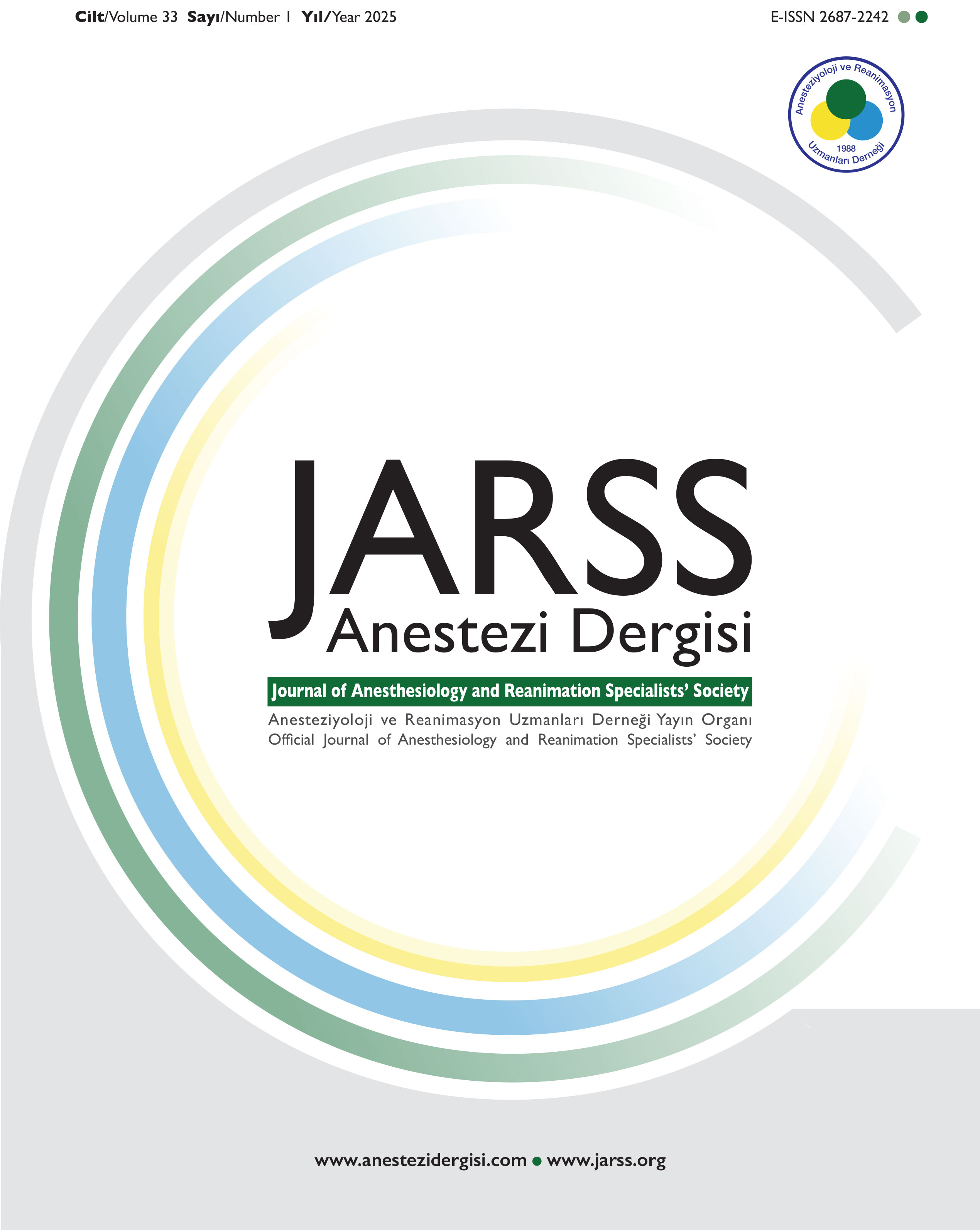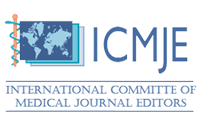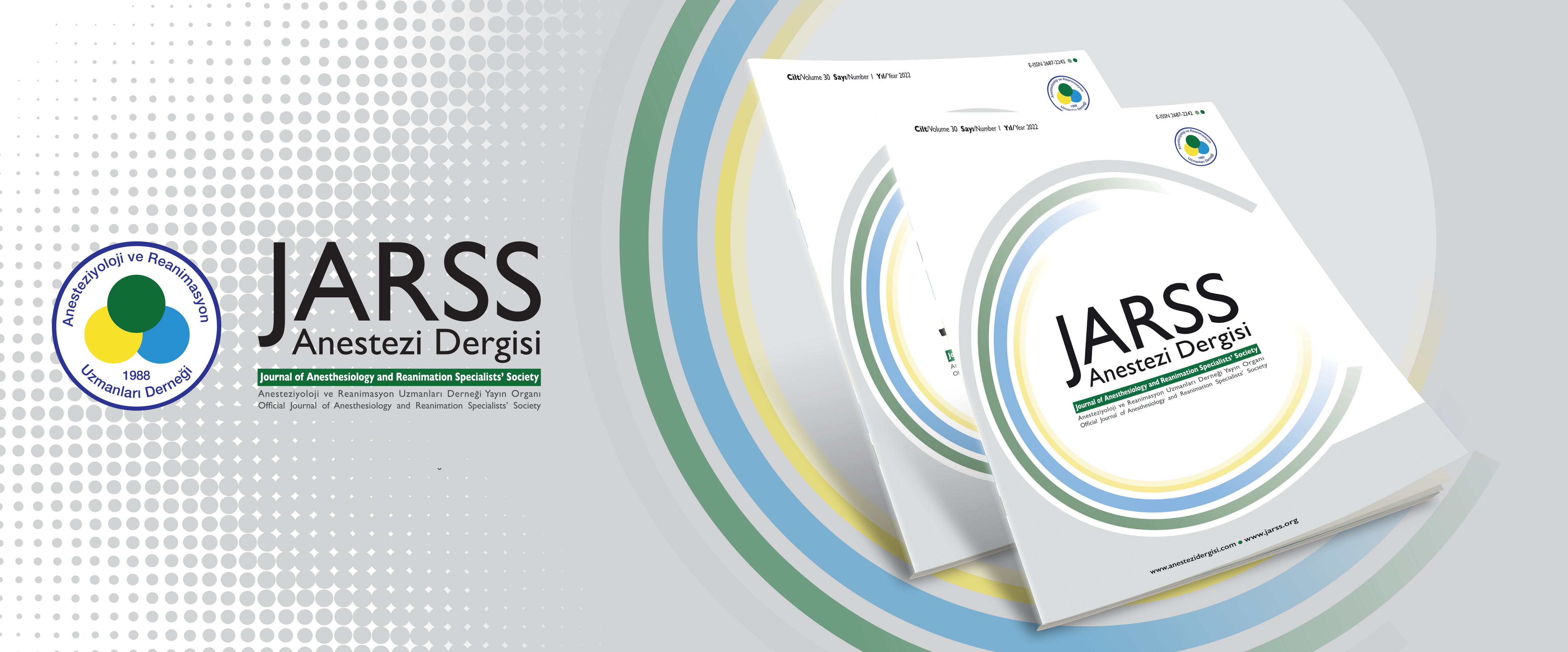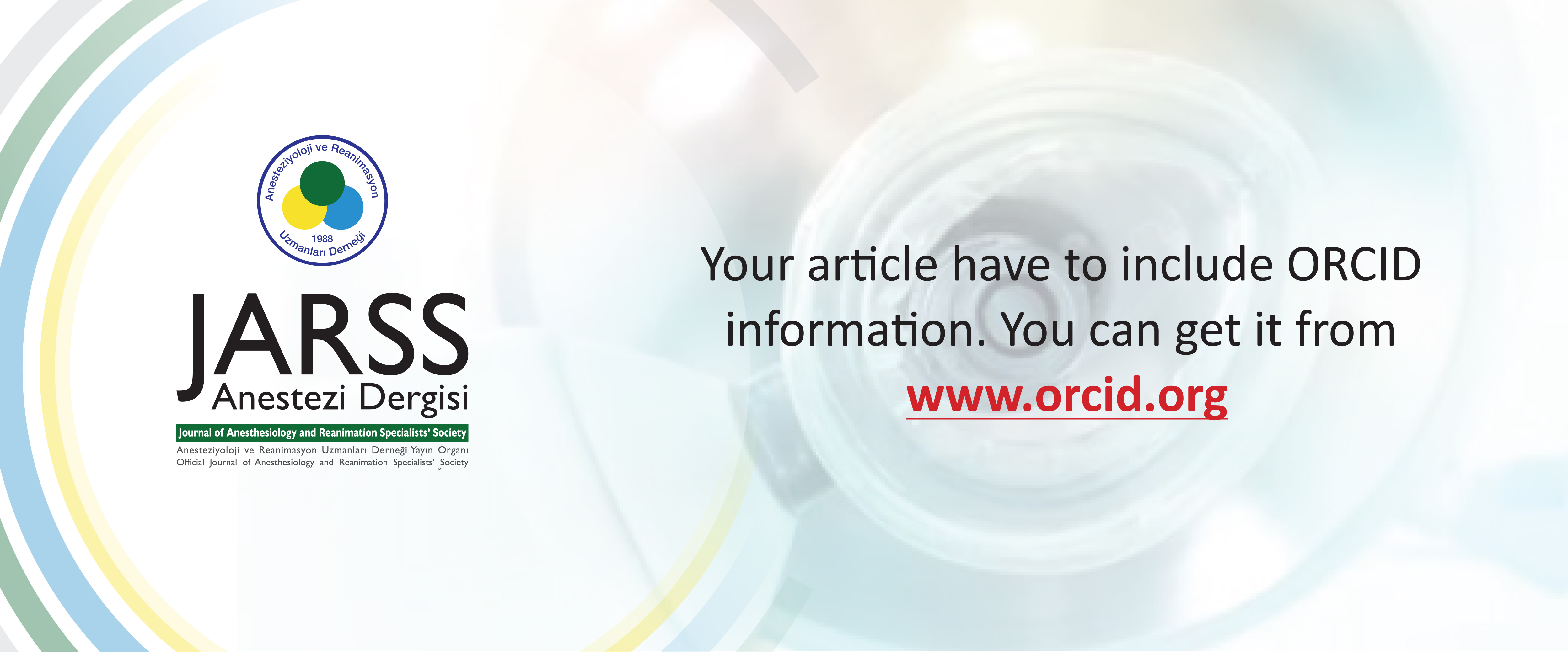Volume: 29 Issue: 3 - 2021
| 1. | Cover Page I (523 accesses) |
| 2. | Advisory Board Pages II - IV (720 accesses) |
| 3. | Contents Pages V - VI (459 accesses) |
| REVIEW | |
| 4. | COVID-19 Vaccines and Anesthesia Semra Gümüş Demirbilek, Çiğdem Sezgin, Canan Gürsoy doi: 10.5222/jarss.2021.93446 Pages 153 - 158 (3360 accesses) The immunization campaigns launched at the national and global level have been a hope to end the COVID-19 pandemic, which has threatened the whole world since December 2019 and left health systems in despair. However, adult vaccination campaigns, which were developed in a short time using new technologies and started with emergency use approval, confronted anesthesiologists with an obscurity. In this review; in general, the interactions of vaccination and anesthesia applications were reviewed, suggestions were made for anesthesia applications after COVID-19 vaccination in adult patients. |
| 5. | Palliative Care in Turkish Medical History Alparslan Koç doi: 10.5222/jarss.2021.50455 Pages 159 - 164 (1805 accesses) From the moment that human beings begin perceiving the value of life, they have also started to strive for the continuation of life. It would not be wrong to divide Turkish societies into three parts as sociological history. Turkish social life before Islam, the differences in the social structure with Islam, and Europe's social structure with the westernization influx with the end of the 19th century can be examined. Health system and patient care was also greatly affected by these processes. Health care, which was carried on with Shamanism and Herbalism in the old Turkish states and continued with bimarhanes and darüssifas, and health professionals have been mobilized to serve the society with the opportunities of modern medicine today. Acute and chronic diseases that occur with the continuation of life make it difficult to lead a quality life. This process can sometimes be painful. Palliative care is also useful in chronic diseases whose mortality has decreased with successful treatment methods recently applied, but which impairs the quality of life due to the disease. Thus, this process, which puts the patient's relatives psychologically, socially, and financially difficult, and the patient, can be managed more easily. Although it started with reducing and caring for cancer patients' pain, palliative care has now become a necessity in all areas of clinical practice. Our aim in this review is to examine the development process of the concept of palliative care in Turkish medical history. |
| ORIGINAL RESEARCH | |
| 6. | Anesthesiologists’ Approach to the Treatment of Catheter Related Bladder Discomfort: A Survey Study Ülkü Ceren Köksoy, Züleyha Kazak Bengisun, Hakan Yılmaz, Baturay Kansu Kazbek, Filiz Tüzüner doi: 10.5222/jarss.2021.60566 Pages 165 - 171 (704 accesses) INTRODUCTION: Urinary catheterization causes catheter related bladder discomfort (CRBD) in the early postoperative period following all surgeries. CRBD mostly develops after urological interventions and has two independent predictors: Male gender and urinary catheters ≥ 18F. We aimed to investigate the awareness of anesthesiology and reanimation specialists to CRBD and its treatment. METHODS: After ethics committee approval, a questionnaire with informed consent of 20 multiple-choice and open-ended questions was transferred to docs.google.com. and Turkish Society of Anesthesiology and Reanimation Specialists were contacted for contribution. RESULTS: 144 anesthesiologists, 26-66 years old (39.5±8.02 years), 54.5% males, 45.5% females, 66.4% with a teaching position and 55.5% with >10 years of experience participated. 54.4% reported encountering >1 CRBD per week and mostly following urology (70.9%), obstetrics and gynecology (52.5%) and general surgery (51.1%) cases. The frequency and severity (66% and 69.5%) of CRBD was reported higher in male patients. 94.4% agreed that CRBD should be treated. 37.8% believed the surgeon should manage CRBD, 60.1% believed it should be planned together. All male participants stated treatment was necessary (p=0.008). Participants chose preemptive (19.9%, n=28), symptomatic (80.1%, n=113) or both (4.3%, n=6) treatments. The choices for preemptive and symptomatic treatment were similar; non-steroidal anti-inflammatory drugs (70.8%, 59%), paracetamol (43.4%, 50.7%) and tramadol (18.9%, 21.6%). Participants’ knowledge on factors effecting CRBD was lacking. DISCUSSION AND CONCLUSION: Anesthesiologists do not utilize preemptive and effective treatment for CRBD; one thirds of them do not consider it their responsibility. Anesthesiologists should be aware of CRBD and participate in the treatment using multimodal approaches. |
| 7. | Impact of COVID-19 Pandemic on the Management of Blood Supply and Demand in Turkey Büşra Tezcan doi: 10.5222/jarss.2021.62534 Pages 172 - 177 (929 accesses) INTRODUCTION: Coronovirus disease(COVID-19)rapidly spread worldwide after its first report in December 2019,in China.This spread drastically reduced the number of blood donations,thereby creating a shortage at blood banks in the whole world.Turkish Red Crescent(TRC) is the only legal authority that organizes collection,production,storage and distribution of blood and blood components in Turkey.Only in case of emergencyTRC gives permanent permission to hospitals;for collecting blood and producing its components through their own transfusion centers.This report describes how theCOVID-19 impacted blood supplies ofTRC and hospital demands in Turkey with an aim to improve the management of blood supply and demand during theCOVID-19 and future pandemics. METHODS: A cross-sectional study was conducted for a period of nine months;from November 1,2019 to July 31,2020.Data were retrospectively obtained from donor attendance and blood inventory records ofTRC and included;1)the number of donated units of apheresis platelet concentrates(APC) and blood toTRC,2)the number of units ofAPC and erythrocyte suspensions(ES) supplied by the hospitals themselves,3)the number of units of APC andES supplied to hospitals by TRC(APCHandESH).The periods before(first period) and after(third period)arrival of COVID-19 to Turkey are compared. RESULTS: An increase of 52%in the number of APCdonations,but a decrease of 22% in the number of blood donations(NBD) were detected in the third period compared to the first one.Mean APCH were 7081±550 and5121±255 units in the first and third periods,respectively.The mean ESH in the first period was 873±326 units,while it was3694±3143 units in the third period. DISCUSSION AND CONCLUSION: It is obvious that we have learnt many lessons from theCOVID-19 pandemic,like how to face challenges in maintaining the balance between blood demandandblood supply.Utilizing media to encourage donors and implementation of PatientBloodManagement on national and institutional levels may be some some of the key components of a comprehensive strategy.The collaboration ofMinistry of Health,TRC and hospitalswassuccessful in securing a balance between blood supply and demand in Turkey,which COVID-19 pandemic impacted significantly. |
| 8. | The Role of Education in Reducing the Disposal Costs of Anesthesia-Related Medical Wastes Gülsen Keskin, Asli Donmez doi: 10.5222/jarss.2021.63935 Pages 178 - 183 (1145 accesses) INTRODUCTION: Although it constitutes a small part of the general waste, medical waste management is important both due to its environmental impact and its cost. Creating education and awareness on reducing the amount of medical waste and increasing the amount of waste-recycling are some of the most important steps. The primary purpose of the study is to determine the role of education in reducing the cost of medical waste belonging to anesthesia, and the secondary purpose is to provide data for the development of educational materials used. METHODS: The anesthesia wastes of 22 operating rooms and 3 PACU were evaluated.Anesthetic wastes were collected and weighed at the end of the day without informing 26 anesthesiologists, 37 anesthesia technicians, and 30 anesthesia assistants.On the 2nd day, the education video link was shared with the participants, and afterwards they were asked to watch and answer the questionnaire prepared.The wastes were collected and weighed again after the training.The approximate annual saving cost was calculated over the medical waste disposal cost, which was determined as 3.50 ₺kg-1 (excluding VAT). RESULTS: The amount of anesthesia waste obtained from 22 operating rooms and 3 PACU was 36.90 kg for 57 cases before training, and 43.36 kg for 64 cases after training.The amount of medical waste was weighed as 461.2 g per case before the training, and 453.8 g per case after the training.It was observed that although not statistically significant, the amount of medical waste decreased (p=0.949).The cost of medical waste disposal decreased by 1.6%. It was learned that 51.3% of the anesthesia team had received training before, and 60.4% benefited from the training provided. DISCUSSION AND CONCLUSION: With education, the amount of medical waste can be reduced.Although there is awareness about waste classification in our clinic, we believe that regular training should be done to reduce the amount of medical waste. |
| 9. | Effects of Intravenous Versus Inhalational Anesthesia on Red Cell Distribution Width and Mean Platelet Volume in Patients Undergoing Coronary Artery Surgery Hülya Yiğit Özay, Zeliha Aslı Demir, Eda Balcı, Melike Kaya Bahçecitapar doi: 10.5222/jarss.2021.64426 Pages 184 - 190 (674 accesses) INTRODUCTION: The effects of midazolam-based intravenous anesthesia (TIVA) and sevoflurane-based inhalation anesthesia (SEVO) maintenance on postoperative hematological parameters were compared in patients undergoing coronary artery surgery. METHODS: The 100 patients included in the study were divided into two groups according to the anesthesia management: All patients' anesthesia inductions were performed with 10 μgkg-1 fentanyl, 0.15 mgkg-1 midazolam, and 0.8 mgkg-1 rocuronium. Anesthesia was maintained with total intravenous anesthesia in the TIVA group patients, while sevoflurane was used in the SEVO group patients. Demographic, clinical, operative data, red cell distribution width (RDW), and mean platelet volume (MPV) values were recorded. RESULTS: Except that the extubation time was shorter in the SEVO group, no difference was observed between the groups in terms of all these variables. There was a significant increase in postoperative RDW and MPV measurements in both groups. Postoperative RDW value was lower in the inhalation anesthesia group compared to the TIVA group (p=0.013). DISCUSSION AND CONCLUSION: In our study, RDW was found to be lower in the inhalation anesthesia group, indicating less inflammation. There was no difference in terms of postoperative complications and mortality. |
| 10. | The Effect of Two Different Doses Protocol of Bupivacaine for Femoral Block on Postoperative Analgesia: A Retrospective Analysis of Single Center Data Adem Selvi, Gokhan Yildiz, Erbil Turksal, Rıdvan Ozbek, Mustafa Caner Okkaoglu, Esra Ozayar doi: 10.5222/jarss.2021.68553 Pages 191 - 195 (1315 accesses) INTRODUCTION: In our study, we aimed to compare the analgesic efficacy, side effect profile and its effect on opioid consumption of the femoral nerve block applied with different concentrations of local anesthetic agents (%0.5 bupivacaine and %0.25 bupivacaine) in the same volume (20 mL) after total knee replacement (TKR) operation. METHODS: The files of patients who underwent unilateral TKR surgery under spinal anesthesia between August 2018 and June 2019 were retrospectively reviewed. A total of 163 patients were included in the study, 81 patients in group 1 who received %0.25 bupivacaine, and 82 patients in group 2 who received %0.50 bupivacaine for femoral block. The highest visual analogue pain scale (VAS) scores in the postoperative 24 hours, the amount of tramadol requested and consumed with intravenous patient-controlled analgesia (PCA) devices, and whether there was a significant difference in terms of side effects (nausea, vomiting, motor and sensory deficit) were analyzed. RESULTS: The highest VAS score in group 1 was 2.95 ± 1.31, in group 2 it was 2.84 ± 1.06, and there was no significant difference between them. The mean consumption of tramadol was 197.04 ± 92.03 mg in group 1 and 208.05 ± 85.06 mg in group 2. There was no difference between the demand and consumption of tramadol and side effects. DISCUSSION AND CONCLUSION: 20 mL %0.25 bupivacaine for the femoral block provided the equivalent analgesic efficacy to the same volume of %0.50 bupivacaine. We think that the use of % 0.25 bupivacaine is a more reliable option to reduce systemic side effects, motor block risk and complications. |
| 11. | The Effect Of Intraoperative Restrictive Fluid Therapy On Postoperative Outcomes In Patients Undergoing Hyperthermic Intraperitoneal Chemotherapy Hülya Yiğit Özay, Nevriye Salman, Demet Bölükbaşı, Perihan Kemerci, Aslı Demir, Ümit Karadeniz doi: 10.5222/jarss.2021.93063 Pages 196 - 201 (1087 accesses) INTRODUCTION: Hyperthermic intraperitoneal chemotherapy (HIPEC) and cytoreductive surgery (CRC) are effective multimodal treatment options in patients with peritoneal carcinomatosis. Procedures are long-lasting operations with excessive blood and fluid loss. Intraoperative fluid management is very important because of major hemodynamic, respiratory and metabolic changes. This study aims to investigate the effect of intraoperative restrictive fluid therapy on postoperative outcome in patients undergoing HIPEC and SRS. METHODS: Patients who underwent HIPEC and SRS in our clinic between 2014-2018 were included in the study. The demographic, intraoperative and postoperative data of all patients were retrospectively analyzed. The patients who underwent restrictive fluid replacement were named Group R, and the group with liberal fluid replacement was named Group L. RESULTS: It was observed that the mean age was 54.6 ± 11.4 years, the female gender was 60.5% and the malignancy originating from the gastrointestinal system was 76.3%. There was no effect of liberal and restrictive fluid treatments on postoperative minor and major complications, length of stay in hospital and intensive care, and mortality. DISCUSSION AND CONCLUSION: We concluded that intraoperative restrictive fluid therapy did not affect postoperative complications and mortality in HIPEC and SRS surgeries. |
| CASE REPORT | |
| 12. | The Use Of Intravenous Immunoglobulin For The Treatment Of Severe Covid-19: Case Presentation For Three Patients Nuh Kumru, Saliha Yarımoglu, Tayfun Et, Rafet Yarımoglu, Muhammet Korkusuz doi: 10.5222/jarss.2021.32032 Pages 202 - 206 (3236 accesses) Although the treatment of the hyperinflammatory response due to COVID-19 has not yet been found, high-dose corticosteroids, interleukin receptor blockers and intravenous immunoglobulin (IVIG) are used to improve the hyperinflammatory response.In this article, we aimed to share our experiences with 3 patients who received IVIG therapy in ICU. |
| 13. | Spinal Anesthesia in Cesarean Section Surgery of the Pregnant Women with Wilson's Disease Harun Özmen, Bahar Aydınlı doi: 10.5222/jarss.2021.10337 Pages 207 - 210 (1042 accesses) Wilson's disease is an autosomal recessive inherited chronic disease that occurs as a result of the deposition of copper in organs and tissues with impaired biliary excretion. With this case report, we aimed to share our experience in cesarean anesthesia in a pregnant woman with Wilson disease who had irregular medical follow-up and underwent chelation therapy. |

















